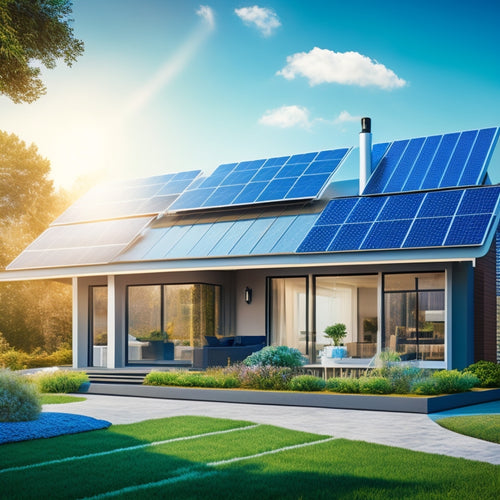
10 Tips: Maximize Efficiency With Hybrid Heat Pumps
Share
By optimizing system sizing, selecting the right hybrid model, and considering fuel source options, you can maximize efficiency with hybrid heat pumps. Insulating pipes, choosing the ideal solar collector, and guaranteeing proper system installation are also essential. Utilize smart thermostat technology to optimize heating and cooling, and maintain clean solar panels to guarantee maximum energy output. Balance heating and cooling needs, and consider energy storage options to reduce grid reliance. By following these tips, you'll be well on your way to revealing the full potential of hybrid heat pumps - and there's even more to uncover when you take a closer look at each of these essential factors.
Key Takeaways
- Accurate system sizing and load calculations are crucial to maximize efficiency and prevent energy waste in hybrid heat pumps.
- Selecting the right hybrid system type and model, considering factors like space constraints and fuel source options, enhances system performance.
- Proper insulation and thermal efficiency techniques, such as using fiberglass batts or foam pipe insulation, reduce energy losses and lower utility bills.
- Regular monitoring and adjustment of system performance, using metrics like temperature and energy consumption, help identify areas for improvement.
- Integration with smart thermostats and energy storage solutions, like battery or thermal storage, optimizes energy efficiency and reduces waste.
Optimize System Sizing for Efficiency
When specifying a hybrid heat pump system, accurately sizing the equipment is vital to maximize efficiency. You must perform a precise load calculation to determine the correct capacity for your system.
This calculation takes into account various factors, including your building's insulation, window orientation, and local climate. Considering the benefits of renewable energy solutions, such as reducing fossil fuel reliance and carbon footprint, it's imperative to enhance system sizing for efficiency.
By accurately sizing your equipment, you'll guarantee superior system performance and minimize energy waste. Oversized systems will waste energy, while undersized systems will struggle to meet your heating and cooling needs.
Conducting a thorough load calculation will help you strike the perfect balance, resulting in a hybrid heat pump system that operates at peak efficiency and provides you with the freedom to enjoy a comfortable and sustainable living space.
Choose the Right Hybrid Model
When selecting a hybrid heat pump model, you'll need to take into account the type of hybrid system that best suits your needs, whether it's an air-source, water-source, or ground-source system.
Additionally, you'll need to decide on a fuel source, such as natural gas, propane, or electric, based on availability, cost, and environmental impact.
To guarantee peak energy efficiency, it's crucial to conduct an energy assessment and needs analysis to determine your energy requirements and identify areas of improvement.
Moreover, you must also factor in space constraints, including indoor and outdoor installation requirements, to guarantee a seamless integration with your existing infrastructure.
Hybrid System Types
Since you're considering hybrid heat pumps, selecting the right hybrid model is essential to maximize efficiency and optimize performance. You have several options to choose from, each with its unique benefits.
Ductless hybrid systems, for instance, offer flexibility and zoning capabilities, allowing you to heat or cool individual areas of your home. Geothermal integration is another option, which takes advantage of the earth's natural temperature to provide supplemental heating and cooling.
In addition, leveraging solar-powered charging solutions can further reduce carbon emissions and energy costs. By integrating energy storage systems, you can optimize your hybrid heat pump's performance and reduce reliance on traditional power sources.
Other hybrid system types include air-source hybrid heat pumps, which combine traditional HVAC systems with heat pump technology, and dual-fuel systems, which use a heat pump in conjunction with a fossil fuel furnace.
Fuel Source Options
Efficiency is the cornerstone of hybrid heat pump systems, and fuel source options play an essential role in achieving it. When choosing the right hybrid model, you'll need to evaluate the fuel source options that align with your goals.
You can opt for renewable energy sources like solar, geothermal, or biomass, which offer a cleaner alternative to fossil fuels.
Prioritizing solar panels with high efficiency ratings can greatly reduce your carbon footprint. Conduct a cost comparison to determine which option provides the best long-term savings.
Additionally, assess the environmental impact of each fuel source and how it affects your carbon footprint. Be sure to check local regulations and incentives for using certain energy sources.
Space Constraints Matter
Hybrid heat pump systems require careful consideration of space constraints to guarantee peak performance.
You'll need to assess the available space in your home or building to choose the right hybrid model. This is similar to enhancing solar panel array design, where strategic orientation and sizing are vital for energy production.
Compact designs and space-saving solutions are essential when working with limited space. Consider the dimensions of the outdoor unit, indoor unit, and any additional components, such as air handlers or ductwork.
Don't forget to factor in clearance requirements and airflow restrictions. By carefully evaluating your space constraints, you can select a hybrid heat pump system that fits seamlessly into your existing infrastructure, providing optimal performance and energy efficiency.
Insulate Pipes for Maximum Gain
Wrapped around your home's foundation, a network of pipes carries refrigerant, playing a vital role in your hybrid heat pump's operation. To maximize efficiency, it's essential to insulate these pipes using proper techniques. By doing so, you'll reap thermal efficiency benefits, reducing energy losses and saving on your utility bills.
| Pipe Insulation Technique | Thermal Efficiency Benefit | Cost-Effectiveness |
|---|---|---|
| Fiberglass batts | 20-30% reduction in heat loss | High |
| Foam pipe insulation | 30-40% reduction in heat loss | Medium |
| Reflective insulation | 40-50% reduction in heat loss | Low |
Select the Ideal Solar Collector
As you design your hybrid heat pump system, incorporating a solar collector is essential to maximize its performance.
You'll need to select the ideal solar collector type, considering factors like collector efficiency, climate, and available space.
There are three primary solar collector types: flat-plate, evacuated tube, and concentrating collectors.
Flat-plate collectors are the most common, offering a balance between cost and efficiency.
Evacuated tube collectors excel in cold climates, while concentrating collectors provide high efficiency but are typically more expensive.
Assess your specific needs and weigh the pros and cons of each type to guarantee peak collector efficiency.
Ensure Proper System Installation
Proper installation is vital to accessing the full potential of your hybrid heat pump system, and it starts with careful planning and execution.
You'll want to create an installation checklist to guarantee every aspect is covered. A professional assessment of your home's unique conditions, such as insulation, window orientation, and local climate, is essential in determining the best system configuration.
| Installation Checklist | Action Item |
| Verify system compatibility | Check for compatibility with existing HVAC systems |
| Conduct site survey | Assess home layout, insulation, and window orientation |
| Determine system size | Calculate required heating and cooling capacity |
| Plan piping and wiring | Confirm efficient and safe installation of pipes and wires |
Monitor and Adjust Performance
With your hybrid heat pump system installed, you're now ready to reap the benefits of enhanced efficiency and cost savings.
To guarantee ideal performance, you'll need to monitor and adjust your system regularly. Performance monitoring involves tracking key metrics such as temperature, humidity, and energy consumption.
By analyzing this data, you can identify areas for efficiency adjustments. For instance, you might adjust the compressor speed or refrigerant flow to enhance performance.
Regular monitoring also helps you detect potential issues before they become major problems. By staying on top of your system's performance, you'll be able to make data-driven decisions that maximize efficiency and minimize energy waste.
Leverage Smart Thermostat Technology
You can optimize your heating and cooling systems by integrating your hybrid heat pump with a smart thermostat, which learns your schedule and preferences to minimize energy waste.
With smart scheduling made easy, you can program your thermostat to adjust temperatures when you're not home or when you're sleeping, ensuring maximum efficiency.
Optimize Heating and Cooling
Frequently, homeowners struggle to find the perfect balance between heating and cooling their homes, resulting in inefficient energy consumption and higher utility bills.
By leveraging smart thermostat technology, you can optimize heating and cooling to achieve maximum efficiency. One key strategy is to employ energy recovery, which involves reusing heat energy that would otherwise be wasted.
This can be achieved through advanced temperature regulation, which allows you to fine-tune your heating and cooling systems to specific zones or areas of your home.
Smart Scheduling Made Easy
By the time you've fine-tuned your temperature regulation, it's essential to create a schedule that complements your daily routine, ensuring your heating and cooling systems operate at peak efficiency. With smart thermostat technology, you can utilize user-friendly interfaces to create a customized schedule that suits your lifestyle. This is especially important for hybrid heat pumps, which rely on efficient scheduling to maximize energy savings.
| Feature | Benefit | Smart Home Integration |
|---|---|---|
| Geofencing | Automatically adjusts temperature based on your location | Integrates with GPS-enabled devices |
| Scheduling | Customizable temperature settings for different times of day | Syncs with your calendar and daily routine |
| Energy Monitoring | Provides real-time energy usage data | Compatible with smart home energy management systems |
| Remote Access | Adjust temperature settings from anywhere using your smartphone | Integrates with popular smart home platforms |
Energy Efficiency Insights
Optimization opportunities abound when it comes to hybrid heat pumps, and smart thermostat technology is the key to accessing them.
By utilizing this technology, you can gain significant understanding into your energy consumption patterns. Smart thermostats can track your energy usage in real-time, providing you with detailed reports on your energy consumption.
This data allows you to identify areas for improvement, making adjustments to optimize your system's efficiency ratings. With smart thermostat technology, you can also set custom energy goals, receive alerts when energy consumption is high, and adjust your settings to maximize efficiency.
Maintain Clean Solar Panels Always
During periods of high energy output, even a thin layer of dirt or grime on your solar panels can greatly reduce their efficiency.
You'll want to prioritize solar panel maintenance to guarantee peak performance. Effective cleaning techniques involve using a soft-bristled brush or a microfiber cloth to gently remove debris.
Avoid using harsh chemicals or abrasive materials that can scratch the panels. For more thorough cleaning, consider using a mixture of water and mild soap, or a specialized solar panel cleaning solution.
Regular cleaning will help you maximize energy output and maintain your system's overall efficiency.
Balance Heating and Cooling Needs
When balancing your heating and cooling needs, you'll want to optimize system sizing to guarantee your hybrid heat pump can handle the maximum load requirements of your building.
This involves calculating the precise heating and cooling capacities needed for each zone, considering factors like insulation, window orientation, and local climate.
Optimize System Sizing
By carefully evaluating your building's unique heating and cooling requirements, you can guarantee a hybrid heat pump system that's specifically customized to meet its needs.
A thorough load calculation is essential to optimize system sizing, ensuring your hybrid heat pump operates at maximum system efficiency. This involves analyzing factors such as insulation, window orientation, and local climate to determine the precise heating and cooling loads.
With accurate calculations, you can avoid oversizing or undersizing your system, which can lead to reduced system efficiency, increased energy bills, and a shorter lifespan.
Zone Temperature Control
A well-designed hybrid heat pump system hinges on zone temperature control, which allows you to balance your building's unique heating and cooling needs.
By dividing your space into distinct zones, you can customize temperature settings to create comfort zones customized to your preferences. This flexibility guarantees energy savings, as you only heat or cool areas that need it.
With zone temperature control, you can make seasonal adjustments remotely, adjusting to climate variations with ease. Energy monitoring capabilities also enable you to track your usage and optimize your system's performance.
Consider Energy Storage Options
You've likely already considered the benefits of hybrid heat pumps, but now it's essential to think about how to optimize their performance by integrating energy storage options.
When it comes to energy storage, you have two primary options: battery storage and thermal storage. Battery storage allows for off-peak charging, reducing your reliance on the grid during peak hours. Thermal storage, on the other hand, stores excess heat energy generated by your hybrid heat pump, which can be used later to supplement your heating needs.
To maximize efficiency, you'll need to develop integration strategies that optimize load management and renewable collaboration. Conduct a thorough cost analysis to determine the most cost-effective approach, and track your efficiency metrics to guarantee you're getting the most out of your system.
Frequently Asked Questions
Can Hybrid Heat Pumps Be Installed in Existing Homes?
You can definitely install hybrid heat pumps in existing homes, as long as you meet specific installation requirements, ensuring a seamless integration that releases significant energy savings and freedom from high utility bills.
Are There Any Government Incentives for Hybrid Heat Pump Installation?
You'll be glad to know that yes, there are government incentives for hybrid heat pump installation, including federal rebates and state incentives, which can markedly offset the upfront cost, giving you the freedom to make an eco-friendly choice.
Do Hybrid Heat Pumps Work Well in Extremely Cold Climates?
You're wondering if hybrid heat pumps can handle frigid temps. The answer lies in their cold climate performance, which is impressive due to hybrid systems' efficiency in optimizing heat output, ensuring your freedom from chilly winters, even in extremely cold climates.
Can I Install a Hybrid Heat Pump Myself to Save Money?
You're considering DIY installation to save on cost, but unless you're highly skilled, it's not recommended, as improper installation can lead to reduced efficiency, increased energy bills, and even safety hazards, ultimately negating any potential cost savings.
Are Hybrid Heat Pumps Compatible With Radiant Floor Heating Systems?
As you venture into the world of hybrid heat pumps, you'll find they're a perfect match for radiant floor heating systems, offering seamless system compatibility and enhancing radiant efficiency, allowing you to savor the freedom of a cost-effective, eco-friendly heating solution.
Related Posts
-

Sustainable Scrubbing: Top Bathroom Solutions for Earth-Conscious Homes
You're taking an important step towards creating a more sustainable home by switching to eco-friendly bathroom cleani...
-

7 Best Cool Roof Rebates for Energy-Savvy Homeowners
You're an energy-savvy homeowner looking to install a cool roof, and you're wondering which rebates can help you save...
-

10 Best Energy-Efficient External Hard Drives for Sustainable Offices
When it comes to sustainable offices, you need external hard drives that balance data storage needs with energy effic...


